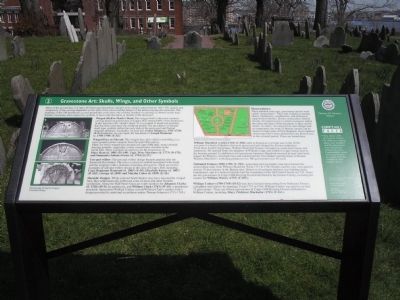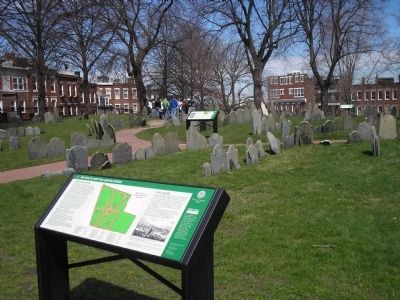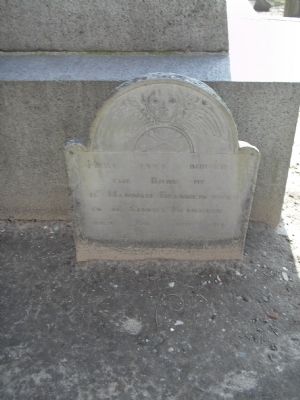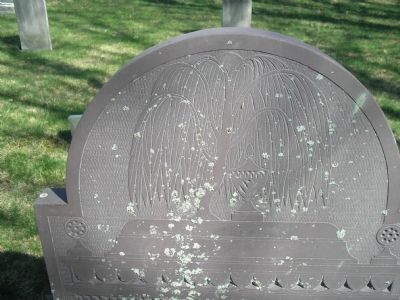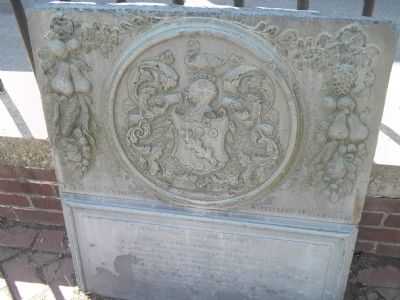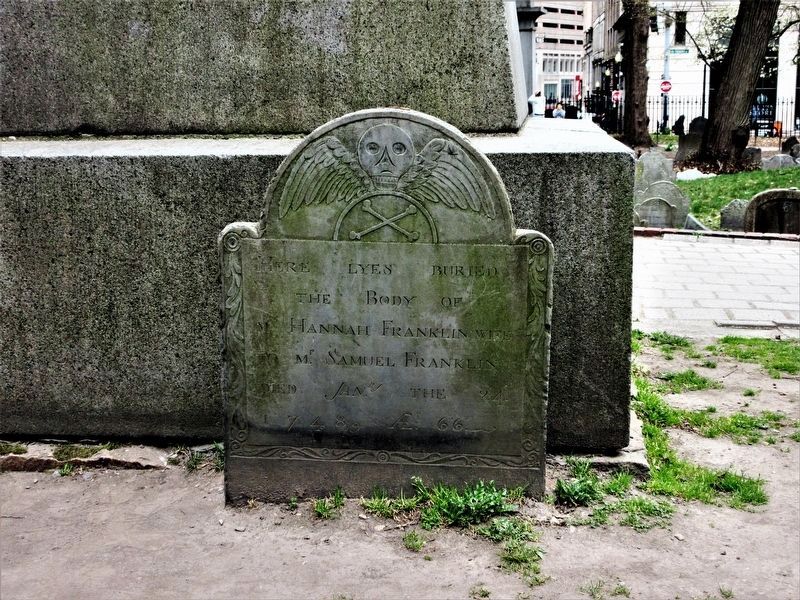North End in Boston in Suffolk County, Massachusetts — The American Northeast (New England)
Gravestone Art: Skulls, Wings, and Other Symbols
Inscription.
Most of the gravestones in Copp’s Hill Burying Ground are upright stone markers placed before 1825. The quality and complexity of the carving depended on the skill of the carver and the budget of the person buying the memorial. The majority of the 100 headstones in and around this circle have one of three symbols or carving as shown on the map. Smaller footstones often repeat the symbols or have only the name or initials of the deceased.
Winged Skull or Death’s Head: The winged skull is the most common carving found on gravestones in Copp’s Hill. Around 80% of the headstones in this area have the “death’s head.” It is a symbol of death and mortality that has been used since the medieval period. The prevalence of winged skull-type symbols reflect the early date of the graveyard and Puritan religious influence. Examples: on your left, Grace Palmer (c. 1705-1750) (E-9) headstone; on your right, the headstone of Joseph Hammatt (c. 1750-1798) (E-32.)
Winged Face or Cherub: The winged face, also called a soul effigy, is a more genial symbol common from the mid-18th century.
There are fewer winged face designs at Copp’s Hill than some colonial burying ground, suggesting a more conservative clientele in the North End. Three examples around you are the headstones of Mary Hunt (d. 1801), Capt. Peter Mortimer (d. 1773) (D-178), and Susannah (Adams) Foster (d. 1794) (E-37.)
Urn-and-willow: The urn-and-willow design became popular after the American Revolution. The urn is a classical symbol associated with death and the weeping willow indicates mourning and sorrow. There are twelve examples of urn-and-willow design in this area of Copp’s Hill, including Capt. Benjamin Hammatt (d. 1805) (E-30), Elizabeth Kenny (d. 1807) (D-155), George (d. 1804) and Martha Cabot (d. 1809) (E-10.)
Heraldic Designs: While colonial North Enders may have rejected the winged face, they enthusiastically embraced coats-of-arms and other heraldic symbolism. Along the Hull Street fence are tomb markers for Johannis Clarke (d. 1728) (W-9), an apothecary, and William Clark (1743) (W-10), a prominent merchant. Stonecutter William Codner carved William Clark’s marker with a design provided by artist and escutcheon maker Thomas Johnson (1715-1765).
Stonecutters
Three hundred years ago, gravestone carvers were called “stonecutters.” They also worked as masons, slaters, bricklayers, woodcarvers, and farmers to support their families. Boston stonecutters offered already decorated stones to which customers added the name and dates of the deceased, or they carved stones “to order.” As many towns and villages had no stonecutter, the work of Boston carvers can be found
in many parts of New England. Over eighteen stonecutters have been identified in the Boston area in the colonial period. Three are buried here.
William Mumford (c. 1641-1718) (C-356) came to Boston as a servant and, in the 1670s, was part of a band of Quakers that were persecuted and whipped by Boston authorities. From these humble beginnings, William Mumford became a prosperous stonecutter/mason and landowner. He married Ruth, the daughter of William Copp, and settled in Copp’s house next to the burying ground. In addition to his gravestone business, Mumford invested in land, built brick houses for Boston’s merchant class and constructed the first Quaker meeting house in Boston. William Mumford’s workshop produced over 100 gravestones over 30 years.
Nathaniel Emmes (1690-1750) (C-294), stonecutter and inn holder, may have learned the stonecutting trade from William Mumford. From 1717 to 1750, Emmes and his sons were paid for at least 78 gravestones in the Boston area. However, his primary business was building stone foundations, and it is believed that he laid the foundation of the Old South Church in 1729. There are ten gravestones in Copp’s Hill Burying Ground attributed to the Emmes Family, including the marker for William Walters (1757) (F-253.)
William Codner (1709-1769) (H-52) may have learned stonecutting from Nathaniel Emmes, a neighbor and relative by marriage. From 1731 to 1764, William Codner was paid for at least 75 gravestones. There are fifteen gravestones in Copp’s Hill Burying Ground attributed to William Codner, including Mary (Nickless) Blackador (1751) (F-161.)
Topics and series. This historical marker is listed in these topic lists: Cemeteries & Burial Sites • Colonial Era. In addition, it is included in the Quakerism series list. A significant historical year for this entry is 1825.
Location. 42° 22.03′ N, 71° 3.372′ W. Marker is in Boston, Massachusetts, in Suffolk County. It is in North End. Marker can be reached from Hull Street, on the left when traveling east. Marker is located along the walking trail in Copp's Hill Burying Ground. Touch for map. Marker is in this post office area: Boston MA 02113, United States of America. Touch for directions.
Other nearby markers. At least 8 other markers are within walking distance of this marker. Copp’s Hill Burying Ground (here, next to this marker); Welcome to Copp’s Hill Burying Ground (a few steps from this marker); a different marker also named Copp's Hill Burying Ground (a few steps from this marker); Copp’s Hill and the American Revolution (a few steps from this marker); From Colonial Burying Ground to Victorian Park (within shouting distance of this marker); Unusual Gravestones (within shouting distance of this marker); Seventeenth Century Copp’s Hill (within shouting distance of this marker); Tombs and Monuments (within shouting distance of this marker). Touch for a list and map of all markers in Boston.
More about this marker. The left side of the marker features photos, provided by Viamonte Design, of three of the types of designs found on Copp’s Hill gravestones, including Death’s Head, Cherub and Urn-and-Willow.
The top of the marker contains a map of Copp’s Hill Burying Ground showing “Some Locations of Gravestone Symbols.”
The right side of the marker contains Copp’s Hill Facts
• Only about 2,200 gravestones remain.
• In 1838 new walking paths were installed and the gravestones were moved and arranged in rows. Consequently, many of the gravestones no longer mark the location of their owner’s grave.
Related markers. Click here for a list of markers that are related to this marker. Take a tour of the markers found in Copp’s Hill Burying Ground.
Also see . . . Copp's Hill Burying Ground. Details of the Freedom Trail from the City of Boston website. (Submitted on May 13, 2009, by Bill Coughlin of Woodland Park, New Jersey.)
Credits. This page was last revised on May 9, 2023. It was originally submitted on May 13, 2009, by Bill Coughlin of Woodland Park, New Jersey. This page has been viewed 8,919 times since then and 93 times this year. Last updated on February 8, 2022, by Carl Gordon Moore Jr. of North East, Maryland. Photos: 1, 2, 3, 4, 5. submitted on May 13, 2009, by Bill Coughlin of Woodland Park, New Jersey. 6. submitted on April 25, 2023, by Mira Earls of Cortland, New York. • J. Makali Bruton was the editor who published this page.
